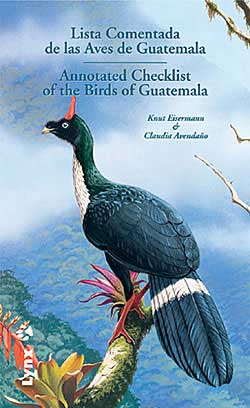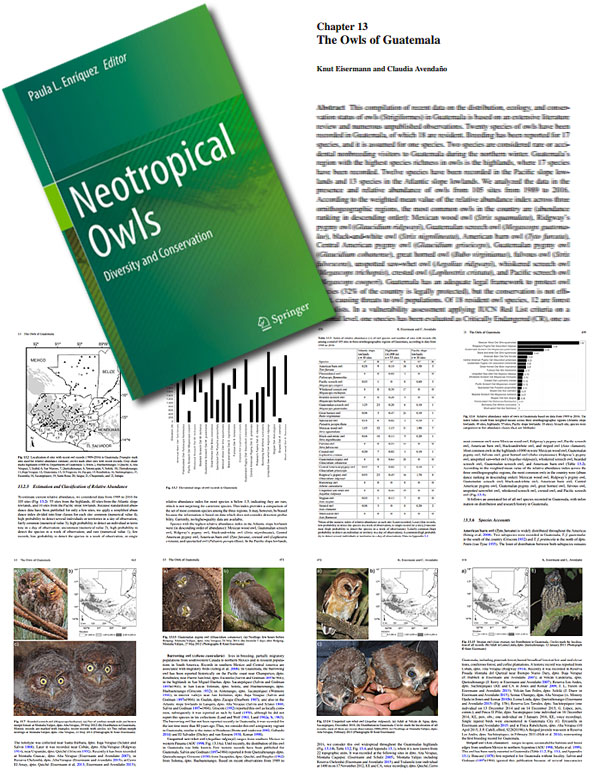A brief history of ornithology Guatemala
Ornithology, the scientific study of birds, belongs to the earliest branches of biological sciences. In a way, already the ancient Maya practiced ornithology in Guatemala. They studied sacred birds such as Quetzals (Pharomachrus mocinno) and Scarlet Macaws (Ara macao). Although no written document on the biology of these species is known from the Maya era, they must have possessed a good knowledge on the natural history of these species in order to harvest feathers for the exuberant ceremonial costumes of the rulers (Tozzer & Allen 1910).

Thorough documentation in Guatemalan ornithology began in the 19th century, after Guatemala declared its independence from Spain in 1821 and facilitated the immigration and travel of European and North American foreigners. Among the visitors were some naturalists, well stated or sponsored by noblemen in their countries of origin, who were mainly interested in obtaining natural curiosities from the exotic Neotropics. For many decades ornithology was focused on collecting specimen and describing new species. While many European and North American bird species were already described in the 16th century, many of them by Linnaeus, the first Central American bird species were described until the 19th century.
One of the most important pioneer explorers and contributors to Guatemalan ornithology was Osbert Salvin, an English naturalist who edited the "Biologia Centrali-Americana", together with Frederick DuCane Godman. 37 years of scientific labor were put into this monumental work of 63 Volumes (Graham 2002), describing about 50 thousand species of the Central American flora and fauna. Four volumes of the Biologia Centrali-Americana are dedicated to the ornithology in Central America (Salvin & Godman 1879-1904).

In the first half of the 20th century ornithology developed to the next step. Data from bird collections were compiled in taxonomic and distributional works such as Ridgway (1901-1950) and Griscom (1932). Up to there no field guide for bird identification was available. The first work of this kind for Mesoamerica was Blake (1953). This work focused on in-hand identification, without color plates. The first guide book with color plates was Smithe (1966), describing the birds of Tikal and the northern Petén. The first bird guide on Guatemalan birds was published in 1970 (Land 1970), followed by other guides for Mexico and Central America (Edwards 1972, Davis 1972, Peterson & Chalif 1973). The occurring of these identification guides is an indicator that bird species were known. However, there was still very little known about detailed bird distribution and ecology. Alexander F. Skutch was the most important contributor of data on natural history of about 200 Mesoamerican species. In the 1930’s he was working in Guatemala. After Howell & Webb's (1995) landmark guide to the birds of northern Mesoamerica, the most recent compilation of knowledge on bird distribution in Guatemala has been published as chapter on avian diversity in Guatemala (Eisermann & Avendaño 2006), in a book on biodiversity in Guatemala, followed by a completely referenced annotated checklist of the birds of Guatemala (Eisermann & Avendaño 2007)
Although Guatemala harbors the oldest University of Central America founded in 1687, the ‘Universidad de San Carlos’, biology developed to a career in Guatemala until recently. Most published studies have been conducted by foreigners. Published studies in ornithology by native Guatemalan did not occur until the 1990’s.

Since the 1990's research in ornithology focused mainly in applied studies for the conservation of species and their habitats. North American interests and financial support in conservation of North American birds led to studies on migratory species wintering in Central and South America, compiled e.g. by Finch & Stangel (1993). There is still a huge lack of knowledge on the ecology of Guatemalan resident bird species. Extensive research in raptor ecology was realized by the Peregrine Fund's ‘Maya Project’ (1980ies and 90ies, Whitacre 2012). The PROEVAL RAXMU Bird Monitoring Program investigates the distribution of birds in Guatemala and the natural history of selected species, and has also published a completely referenced Annotated checklist of the Birds of Guatemala. The program focusses on little known species, such as owl.


Other programs are conducted in the Maya Biosphere Reserve (Wildlife Conservation Society) and at ‘Cerro San Gil’ (FUNDAECO). Life histories of many bird species of the Guatemalan forests still remain unknown. There is work for decades!